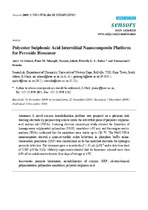| dc.contributor.author | Al-Ahmed, Amir | |
| dc.contributor.author | Ndangili, Peter M. | |
| dc.contributor.author | Jahed, Nazeem | |
| dc.contributor.author | Baker, Priscilla | |
| dc.contributor.author | Iwuoha, Emmanuel I. | |
| dc.date.accessioned | 2016-12-22T07:44:12Z | |
| dc.date.available | 2016-12-22T07:44:12Z | |
| dc.date.issued | 2009 | |
| dc.identifier.citation | Al-Ahmed, A. et al. (2009). Polyester sulphonic acid interstitial nanocomposite platform for peroxide biosensor. Sensors, 9: 9965-9976 | en_US |
| dc.identifier.issn | 1424-8220 | |
| dc.identifier.uri | http://hdl.handle.net/10566/2476 | |
| dc.identifier.uri | http://dx.doi.org/10.3390/s91209965 | |
| dc.description.abstract | A novel enzyme immobilization platform was prepared on a platinum disk
working electrode by polymerizing aniline inside the interstitial pores of polyester sulphonic
acid sodium salt (PESA). Scanning electron microscopy study showed the formation of
homogeneous sulphonated polyaniline (PANI) nanotubes (~90 nm) and thermogravimetric
analysis (TGA) confirmed that the nanotubes were stable up to 230 °C. The PANI:PESA
nanocomposite showed a quasi-reversible redox behaviour in phosphate buffer saline.
Horseradish peroxidase (HRP) was immobilized on to this modified electrode for hydrogen
peroxide detection. The biosensor gave a sensitivity of 1.33 μA (μM)-1 and a detection limit
of 0.185 μM for H2O2. Stability experiments showed that the biosensor retained more than
64% of its initial sensitivity over four days of storage at 4 °C. | en_US |
| dc.language.iso | en | en_US |
| dc.publisher | MDPI | en_US |
| dc.relation.uri | https://creativecommons.org/licenses/by-nc-sa/3.0/ | |
| dc.subject | Peroxide biosensors | en_US |
| dc.subject | Electrochemical polymerisation | en_US |
| dc.subject | Polyaniline nanotubes | en_US |
| dc.subject | Polyester sulphonic acid | en_US |
| dc.title | Polyester sulphonic acid interstitial nanocomposite platform for peroxide biosensor | en_US |
| dc.type | Article | en_US |

